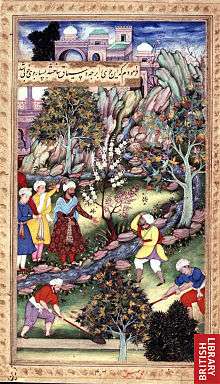Istalif
| Istālif استالف | |
|---|---|
| Village | |
 Istālif Location in Afghanistan | |
| Coordinates: 34°50′N 69°6′E / 34.833°N 69.100°ECoordinates: 34°50′N 69°6′E / 34.833°N 69.100°E | |
| Country |
|
| Province | Kabul Province |
| District | Istalif District |
| Time zone | UTC+4:30 |

Istālif (Persian: استالف) is a village 29 kilometres (18 mi) northwest of Kabul, Afghanistan, situated at an elevation of 1,693 metres (5,554 ft).[1] It is the center of Istalif District, Kabul Province, Afghanistan. The village was destroyed during the long-lasting wars around Kabul. There are a few repaired or newly constructed buildings. The village needs a lot of work to be done to return its previous state. Istalif is famous for its handmade glazed potteries. Its name might derive from Greek staphile ("bunch of grapes") or Parachi estuf ("cow-parsnip"). Istalif was always renowned as one of the most beautiful places in Afghanistan – the Emperor Babur fell in love with it in the 16th century and used to hold parties in his rose garden and summer house there.
Alexander Burnes, a British political agent to Dost Mohammed in the 19th century, had come here to relax amid the plane and walnut trees. He described that the mountains streams are full of fishes and the orchards and vineyards are richest. During the final phase of the First Anglo-Afghan War, as General Pollock's Army of Retribution marched into Kabul, many families fled to Istalif. Troops were dispatched, which surrounded the town, attacked, and then systemically pillaged it. The British and Indian soldiers set fire to the cotton cloth of their victims and burnt them alive. They massacred women and children as well.[2]
References
- ↑ National Geospatial-Intelligence Agency. Geonames database entry. (search) Accessed 2011-05-12.
- ↑ Dalrymple, William. Return of a King: The Battle for Afghanistan, 1839-42. New York: Knopf, 2013. Print. pp. 407-409
External links
| Wikivoyage has a travel guide for Istalif. |